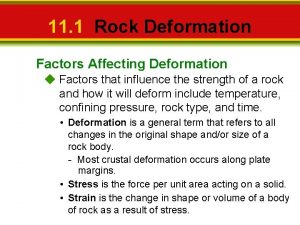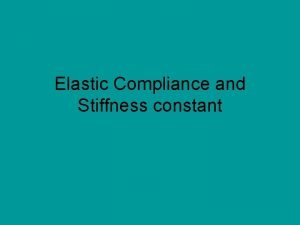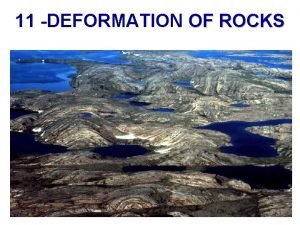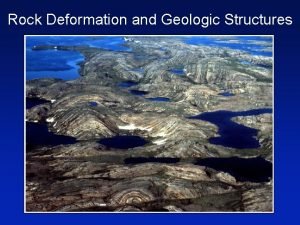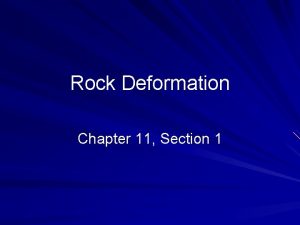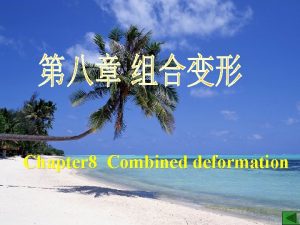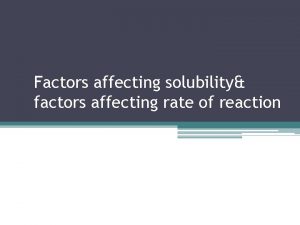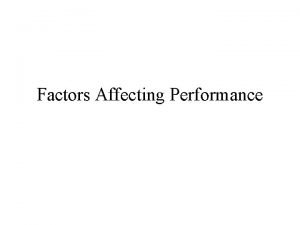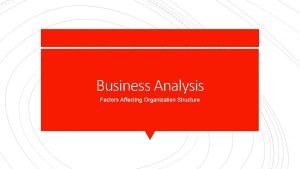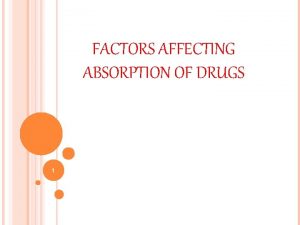CHAPTER 11 1 Rock Deformation FACTORS AFFECTING DEFORMATION














- Slides: 14

CHAPTER 11. 1 Rock Deformation

FACTORS AFFECTING DEFORMATION Deformation – refers to all changes in the original shape and/or size of a rock body. Most plate motion and interactions create force that will cause a rock to deform. Stress – the force per unit area acting on a solid. When stress is put on rocks larger than their own strength they will deform by folding, flowing, or fracturing. Strain is a change in shape or volume of a rock as a result of stress. Temperature, confining pressure, rock type, and time all influence the strength of a rock and how it will deform.

TEMPERATURE AND PRESSURE Rocks deform permanently in 2 ways: brittle deformation and ductile deformation. Brittle deformation – rocks near the surface where there is low temperature and pressure will fracture once their strength is exceeded. Ductile deformation – when rocks are underground where temperature and pressures are high then it produces solid-state flow and changes the size and shape of the rock without fracture. (think of how clay can change shape without coming apart)

ROCK TYPE Mineral composition and texture affect how a rock deforms. Granite and basalt have strong bonds and will only break by brittle fracture. Sedimentary rocks or certain metamorphic rocks will deform by ductile flow.

TIME Small stresses over a long period of time may cause rock deformation. If forces are applied over a long period of time they may cause a rock to deform, when initially they wouldn’t.

TYPES OF STRESS There are 3 types of stresses: tensional stress, compressional stress, and shear stress. Tensional stress – when rocks are being pulled in opposite directions. Compressional stress – when rocks are squeezed or shortened. Shear stress – when a body of rock is distorted.

FOLDS During mountain building sedimentary rock and volcanic rocks are bent into wavelike ripples called folds. There are 3 main types of folds: anticlines, synclines, and monoclines.

ANTICLINES AND SYNCLINES Anticline – formed by upfolding (arching) of rock layers. Synclines – downfolds or troughs. The angle of the fold is called the dip of the fold or fault. Flat rocks have a dip of 0˚ and a vertical fold or fault would have a dip of 90˚.

MONOCLINES Monoclines are large, step-like fold in a horizontal sedimentary strata.

FAULTS Faults are fractures in the crust where movement has taken place. Small faults may show where the rock has been offset a few meters. Large faults may have hundreds of meters of rock offset. Major faults types are: normal faults, reverse faults, thrust faults, and strike-slip faults.

NORMAL FAULTS This is when a hanging wall block moves down relative to the footwall block. Normal faults will lengthen the crust.

REVERSE FAULTS AND THRUST FAULTS A reverse fault is a fault where hanging wall block moves up relative to the footwall block. Thrust faults are reverse faults with dips of less than 45˚. These faults shorten the crust.

STRIKE-SLIP FAULTS This is where the movement is horizontal and parallel to the trend or strike. These areas will have zones of parallel fractures. The San Andreas Fault is a strikeslip fault.

JOINTS Joints are fractures where no movement has occurred.
 Factors affecting rock deformation
Factors affecting rock deformation Igneous metamorphic sedimentary
Igneous metamorphic sedimentary Stress strain curve toughness
Stress strain curve toughness Deformation
Deformation Deformation rock cycle
Deformation rock cycle Basin vs dome
Basin vs dome Rock cycle sedimentary
Rock cycle sedimentary Igneous metamorphic sedimentary
Igneous metamorphic sedimentary Extreme sports bungee jumping
Extreme sports bungee jumping A rock climber's shoe loosens a rock and her climbing buddy
A rock climber's shoe loosens a rock and her climbing buddy A rock climber's shoe loosens a rock and her climbing buddy
A rock climber's shoe loosens a rock and her climbing buddy Diagram of rock cycle class 7
Diagram of rock cycle class 7 What factors shape the climate in canada
What factors shape the climate in canada Factors affecting microbial growth in food
Factors affecting microbial growth in food Types of volcanoes
Types of volcanoes
